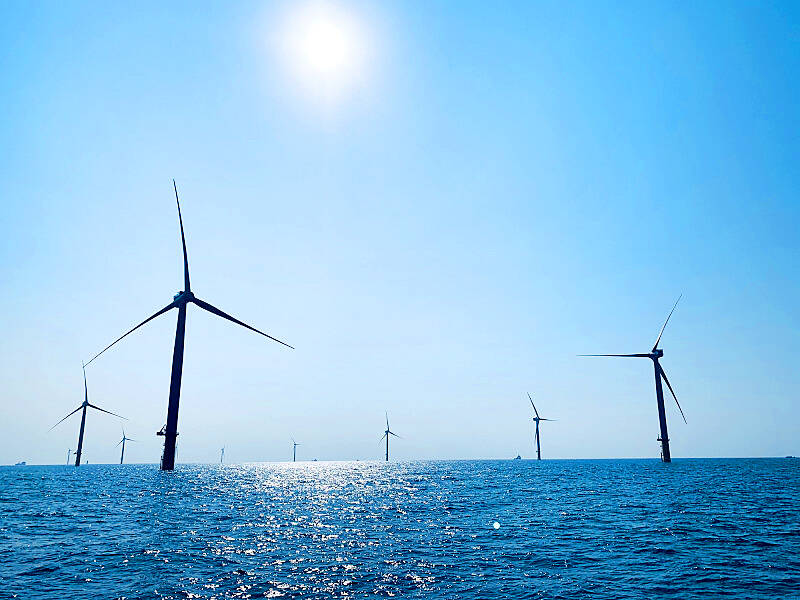Electricity generated by solar and wind sources made up more than 50 percent of the nation’s energy mix at 12:21pm on Sunday, a record high that saw renewable energy surpass coal power, Taiwan Power Co (Taipower) said.
Electricity produced from solar and wind sources totaled 10.01 gigawatts (GW) accounting for 52.37 percent of all power generated at the time, the state-owned utility said in a news release.
It is a huge leap for Taiwan given that during the Lunar New Year holiday in January last year, electricity generated by solar and wind sources broke the 30 percent mark for the first time, it said.

Photo: Lin Ching-hua, Taipei Times
Taiwan also hit a new milestone at about noon on Sunday, as solar energy sources generated 8.09GW of power, surpassing 8GW for the first time, Taipower said.
Due to a weather front moving south, electricity generated by wind sources rose to 1.9 gigawatts at about noon on Sunday, it added.
The increase in power generated by renewable sources means Taipower can conduct maintenance on coal and nuclear plants so that they are ready for the peak electricity consumption season in summer, the firm said.
The government has set a target of acquiring 15 percent of the nation’s power from renewable sources by 2025.

Taiwanese scientists have engineered plants that can capture about 50 percent more carbon dioxide and produce more than twice as many seeds as unmodified plants, a breakthrough they hope could one day help mitigate global warming and grow more food staples such as rice. If applied to major food crops, the new system could cut carbon emissions and raise yields “without additional equipment or labor costs,” Academia Sinica researcher and lead author the study Lu Kuan-jen (呂冠箴) said. Academia Sinica president James Liao (廖俊智) said that as humans emit 9.6 billion tonnes of carbon dioxide compared with the 220 billion tonnes absorbed

The Taipei Mass Rapid Transit (MRT) Wanda-Zhonghe Line is 81.7 percent complete, with public opening targeted for the end of 2027, New Taipei City Mayor Hou You-yi (侯友宜) said today. Surrounding roads are to be open to the public by the end of next year, Hou said during an inspection of construction progress. The 9.5km line, featuring nine underground stations and one depot, is expected to connect Chiang Kai-shek Memorial Hall Station to Chukuang Station in New Taipei City’s Jhonghe District (中和). All 18 tunnels for the line are complete, while the main structures of the stations and depot are mostly finished, he

Taipei is to implement widespread road closures around Taipei 101 on Friday to make way for large crowds during the Double Ten National Day celebration, the Taipei Department of Transportation said. A four-minute fireworks display is to be launched from the skyscraper, along with a performance by 500 drones flying in formation above the nearby Nanshan A21 site, starting at 10pm. Vehicle restrictions would occur in phases, they said. From 5pm to 9pm, inner lanes of Songshou Road between Taipei City Hall and Taipei 101 are to be closed, with only the outer lanes remaining open. Between 9pm and 9:40pm, the section is

China’s plan to deploy a new hypersonic ballistic missile at a Chinese People’s Liberation Army Rocket Force (PLARF) base near Taiwan likely targets US airbases and ships in the western Pacific, but it would also present new threats to Taiwan, defense experts said. The New York Times — citing a US Department of Defense report from last year on China’s military power — on Monday reported in an article titled “The missiles threatening Taiwan” that China has stockpiled 3,500 missiles, 1.5 times more than four years earlier. Although it is unclear how many of those missiles were targeting Taiwan, the newspaper reported